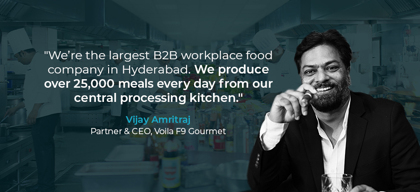The Omnichannel Retail Experience Is Here to Stay, But How Will it Evolve?

Retail
81 week ago — 8 min read
For the past 5-6 years, words like omnichannel, customer experience, AI/ ML, data collection, and D2C have become commonplace in the retail sector. We would examine case studies, and marvel at the disruptions several companies had made.
Then the pandemic hit us, and what was a disruption became the norm. The internet became a gigantic shopping centre where everyone from a startup to a Fortune-500 company were selling. We reduced trips to the local supermarket, and started ordering our grains, pulses, fruits, and vegetables online.
We now live in a world where we have been spoiled by the vast cornucopia that the online world gives us. Despite this, companies want people to step out of the comfort of their homes and visit a physical store. Now visiting a physical store has become an experience. These physical stores take the form of a popup in a mall, or a regular rented space. And as we all know, a visit to the mall has become a daylong family outing that comprises visiting several stores, watching a movie, and eating at a restaurant.
A combination of technology and analytics has given us more insights into a customer’s personalised journey. Data can be used in two ways: what happened, and what can happen. - Sandeep Jabbal, Chief Digital Transformation Officer, Shoppers Stop
“There are several questions that arise when you talk about the customer experience,” said RAI Chairman Biju Kurien, while speaking at the Retail Tech Conclave (ReTeCon) 2022. “What do we know about the customer? Why do they visit the store? Why are store visits still lower than online purchases? What is the perfect balance to define a truly omnichannel experience?” he added.
These questions are profound, and have several layers to give the perfect answer, but with the pace at which the world is moving, the omnichannel experience may change once again in the next 12-18 months. “Companies have invested in digital technology to achieve the following: understand the customer; a seamless customer experience; connect with suppliers; and connect with consumers,” added Kurien.
Vikram Idani, Senior VP and Head of Information Technology at Reliance agreed with Kurien, saying that there wasn’t a single answer for all the questions asked. “The customer experience is a collection of data points that you capture during the purchase journey. This can be generic or specific information. For example: you may want to buy a formal white shirt (specific) or a pair of trousers (generic). This, along with the purchase is defined as a data point,” he explained.
Other factors that make up data points include net promoter score (NPS), browsing journey, and the feedback you get from delivering (or not delivering) a product on time.
Some Focus More on Physical
Vipin Gupta, CTO at Starbucks India said that a coffee shop such as Starbucks is more of the place you visit between home and work. “In our case, technology has always been a secondary factor. The primary focus is our baristas acting as our company representatives, and personalising their order. There are regulars who visit, and through previous data, we can pick up their usual orders,” he said.
Gupta’s sentiments were echoed by Toni & Guy CEO Blessing A Manikandan, who said that while their products are available online, you have to get a haircut at a physical outlet. “That experience is a personal one, and there is no way we can make that online,” he added.
Also read: How to have the perfect mix of a phygital (physical + digital) store?
D Is For Digital
Sandeep Jabbal, the Chief Digital Transformation Officer at Shoppers Stop said that customers generate revenue to the company, while it is the job of the employee to create the experience for the customer to generate that revenue. “A combination of technology and analytics has given us more insights into a customer’s personalised journey. Data can be used in two ways: what happened, and what can happen. Today, we have customer experience experts plotting emotional graphs and sentiment analytics to enable us serve the customer better,” he said.
Retailers are also challenged – in a good way – by an evolving customer base that looks at new and innovative ways to interact with brands. Whether it’s using digital marketing tools, chatbots, or more state-of-the-art systems, retailers need to constantly evolve.
Dharmarajan K, the Chief Product and Customer Experience Officer at Tata Cliq, added that right now, customer journeys are mapped using an output-based metric. “However, we have a two-fold challenge. Firstly, to improve, we need customer feedback, and feedback is usually given when the customer has a negative experience. Hence, we need to build and connect output metric to input.
Factors Affecting Omnichannel Growth
- Retailers providing digital tech
- Clever synergies between online and offline
- Using relevant customer data to ensure a perfect experience
Thomas Reju, Chief Digital Officer, Ikea India, shared an example of how a family used social media platforms, online shops, and a visit to a physical store to ramp up their house. “At the end, their story became a case study for us, as we were able to feature their customer journey and use it to inspire others to buy products from us,” he said.
What does the future hold?
With a focus on customer experience and building a strong relationship, retailers have to embrace new technologies, stay ahead of the times, and ensure that they do what it takes to deliver that a-ha moment to the consumer. The industry also needs to realise that the customer wants consistency across all channels. Retailers also need to embrace technologies such as chatbots, and AI tools that personalise the customer journey through insights shared by customers.
The experts at the conclave believed that the omnichannel route is the future of retail. Retailers are also challenged – in a good way – by an evolving customer base that looks at new and innovative ways to interact with brands. Whether it’s using digital marketing tools, WhatsApp/FB chatbots, or more state-of-the-art systems, retailers need to constantly evolve their business models to stay relevant in an ever-competing industry.
Omnichannel & Beyond
Gyanesh Sharma, the Co-founder of DotPe said that customers are of two types: one who prefer interacting with people, and others who prefer technology. “We live in a world that combines technology and personalisation to give customers the perfect omnichannel experience,” he said. There is data to back Sharma’s statement. The revenue generated from omnichannel experiences was globally valued at $12 billion in 2022. It is expected to jump by 5x in 2027.
Also read: Transform or Be Transformed
Article source: STOrai Magazine
Image source: Canva
Disclaimer: The views and opinions expressed in this article are those of the author and do not necessarily reflect the views, official policy or position of GlobalLinker.
Most read this week


















Comments
Please login or Register to join the discussion